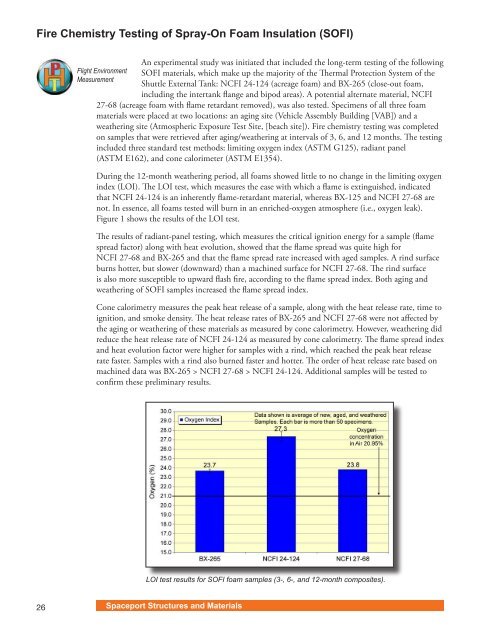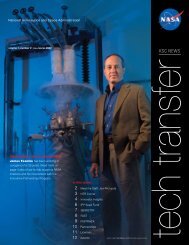2006-2007 - Kennedy Space Center Technology Transfer Office
2006-2007 - Kennedy Space Center Technology Transfer Office
2006-2007 - Kennedy Space Center Technology Transfer Office
- No tags were found...
Create successful ePaper yourself
Turn your PDF publications into a flip-book with our unique Google optimized e-Paper software.
Fire Chemistry Testing of Spray-On Foam Insulation (SOFI)An experimental study was initiated that included the long-term testing of the followingFlight Environment SOFI materials, which make up the majority of the Thermal Protection System of theMeasurementShuttle External Tank: NCFI 24-124 (acreage foam) and BX-265 (close-out foam,including the intertank flange and bipod areas). A potential alternate material, NCFI27-68 (acreage foam with flame retardant removed), was also tested. Specimens of all three foammaterials were placed at two locations: an aging site (Vehicle Assembly Building [VAB]) and aweathering site (Atmospheric Exposure Test Site, [beach site]). Fire chemistry testing was completedon samples that were retrieved after aging/weathering at intervals of 3, 6, and 12 months. The testingincluded three standard test methods: limiting oxygen index (ASTM G125), radiant panel(ASTM E162), and cone calorimeter (ASTM E1354).During the 12-month weathering period, all foams showed little to no change in the limiting oxygenindex (LOI). The LOI test, which measures the ease with which a flame is extinguished, indicatedthat NCFI 24-124 is an inherently flame-retardant material, whereas BX-125 and NCFI 27-68 arenot. In essence, all foams tested will burn in an enriched-oxygen atmosphere (i.e., oxygen leak).Figure 1 shows the results of the LOI test.The results of radiant-panel testing, which measures the critical ignition energy for a sample (flamespread factor) along with heat evolution, showed that the flame spread was quite high forNCFI 27-68 and BX-265 and that the flame spread rate increased with aged samples. A rind surfaceburns hotter, but slower (downward) than a machined surface for NCFI 27-68. The rind surfaceis also more susceptible to upward flash fire, according to the flame spread index. Both aging andweathering of SOFI samples increased the flame spread index.Cone calorimetry measures the peak heat release of a sample, along with the heat release rate, time toignition, and smoke density. The heat release rates of BX-265 and NCFI 27-68 were not affected bythe aging or weathering of these materials as measured by cone calorimetry. However, weathering didreduce the heat release rate of NCFI 24-124 as measured by cone calorimetry. The flame spread indexand heat evolution factor were higher for samples with a rind, which reached the peak heat releaserate faster. Samples with a rind also burned faster and hotter. The order of heat release rate based onmachined data was BX-265 > NCFI 27-68 > NCFI 24-124. Additional samples will be tested toconfirm these preliminary results.LOI test results for SOFI foam samples (3-, 6-, and 12-month composites).26 <strong>Space</strong>port Structures and Materials













